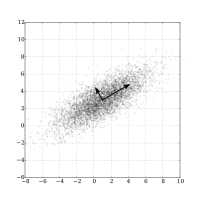
Photo from wikipedia
As understanding the nature of brain networks through dynamic functional connectivity (dFC) estimation is of paramount significant, the introduction and revision of blood-oxygen-level dependent (BOLD) signal simulation methods in brain… Click to show full abstract
As understanding the nature of brain networks through dynamic functional connectivity (dFC) estimation is of paramount significant, the introduction and revision of blood-oxygen-level dependent (BOLD) signal simulation methods in brain regions and dFC estimation methods have gained significant ground in recent years. Based on the observation of BOLD signals with multivariate nonnormal distribution in functional magnetic resonance imaging (fMRI) images, we first propose a copula-based method for the production of these signals, in which nonnormal data are generated with a selected time-varying covariance matrix. Therefore, we can compare the performance of models in the cases where brain signals have a multivariate nonnormal distribution. Then, two kendallized exponentially weighted moving average (KEWMA) and kendallized dynamic conditional correlation (KDCC) multivariate volatility models are introduced which are based on two well-known and commonly used exponentially weighted moving average (EMWA) and dynamic conditional correlation (DCC) models. The results show that KDCC model can estimate conditional correlation significantly far better than the former ones (ie, DCC, standardized dynamic conditional correlation, EWMA, and standardized exponentially weighted moving average) on both types of data (ie, multivariate normal and nonnormal). In the next step, the bivariate normal distribution in Iranian resting state fMRI data is confirmed by using statistical tests, and it is shown that the dynamic nature of FC is not optimally detected using prevalent methods. Two alternative Portmanteau and rank-based tests are proposed for the examination of conditional heteroscedasticity in data. Finally, dFC in these data is estimated by employing the KDCC model.
Journal Title: Statistics in medicine
Year Published: 2020
Link to full text (if available)
Share on Social Media: Sign Up to like & get
recommendations!